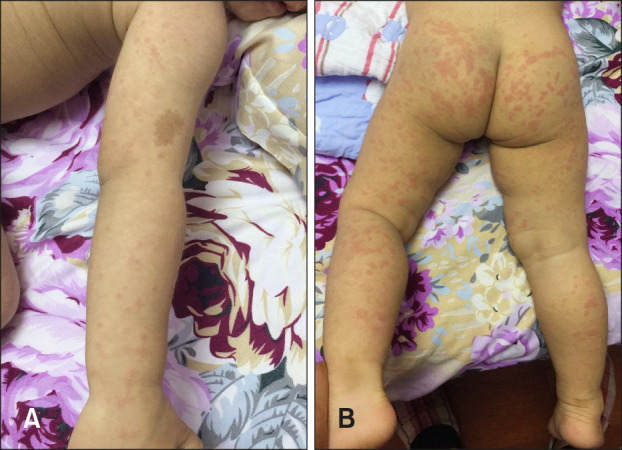Dear Editor:
The group of cryopyrin-associated periodic syndromes (CAPS) includes familial cold autoinflammatory syndrome (FCAS), Muckle–Wells syndrome (MWS), chronic infantile neurological cutaneous articular syndrome (CINCA), and neonatal-onset multisystem inflammatory disease (NOMID). FCAS is characterized by fever flare-ups, fatigue, arthralgia, myalgia, conjunctivitis, vision and/or hearing disorders which is provoked by cold environment1. However, early period of FCAS has no characteristic manifestations2. Here we reported an atypical case with urticaria and conjunctivitis finally diagnosed as FCAS even if his lesion wasn't triggered by the cold.
A 1-year-old Chinese boy presented with recurring urticaria and conjunctivitis associated with low fever (<38℃) since perinatal period (Fig. 1). He was first diagnosed as urticaria, while antihistamine drugs were ineffective. No trigger observed at first. Blood tests showed leukocytosis (17,360/µl) with neutrophilia (11,450/µl). No abnormal results were found on the ophthalmologic examination except for conjunctivitis. A skin biopsy showed moderate perivascular and periadnexal neutrophilic and lymphocytic infiltration, which also supported the diagnosis of chronic urticaria (Fig. 2). Then he was treated with methylprednisolone 4 mg bid. The severity and frequency of skin lesions were improved than before. But the side effects of glucocorticoids like obesity, hirsutism were significant, and the effectiveness was also declined as time went by. Further inquiry revealed that rashes were exacerbated when exposed in the cold environment. High fever (38.6℃) was once accompanied with severe skin rashes and conjunctivitis.
Fig. 1. (A, B) Multiple, red urticarial wheals on the limbs.

Fig. 2. Neutrophilic and lymphocytic infiltrate in the dermis (H&E, original magnification: A, ×200; B, ×200; C, ×400; D, ×400).
Besides, the patient underwent whole exome sequencing. It revealed a heterozygous c.1064T>C transversion in exon 3 of the NLRP3 gene, which leads to the p.(Leu355Pro) missense variant in cryopyrin which has been previously reported in a case of FCAS3. Genetic investigation of his parents didn't detect the missense variant and supported the de novo nature of the patient's mutation.
The differential diagnosis of urticarial eruption should include cold urticaria, familial mediterranean fever (FMF), pyrinassociated autoinflammation with neutrophilic dermatosis (PAAND), Majeed syndrome. Cold urticaria can be triggered by the cold, but mostly doesn't accompany fever and is sensitive to antihistamines. NLRP3 mutation are also related to FMF and Majeed syndrome4. The skin lesions of FMF and Majeed syndrome most commonly report erysipelas-like erythema. FMF is characterized as fever and short-term serositic attacks (peritonitis, pleuritis) while Majeed syndrome is characterized as bone pain and joint swelling. PAAND is commonly associated with MEFV mutation, featured by fever, neutrophilic dermatosis and myalgia/myositis like FCAS. FCAS is characterized by increased interleukin (IL)-1β release due to the NLRP3 mutation, so early treatment against IL-1β like anakinra is essential5. Diagnostic delay of FCAS is frequent since the early phase of clinical feature is not typical especially without family history like this patient. FCAS can turn into MWS or CINCA syndrome with systemic involvement like neurologic damage, arthritis and joint deformity, renal amyloidosis and failure. Chronic urticaria with conjunctivitis and fever insensitive to antiallergic agent is a reminder for CAPS, and further genetic testing to ensure NLRP3 mutation helps to make accurate diagnosis. We received signed consent form from the patient for the publication of all photographic images.
Footnotes
CONFLICTS OF INTEREST: The authors have nothing to disclose.
FUNDING SOURCE: None.
DATA SHARING STATEMENT
Research data are not shared.
References
- 1.Kreft B, Schlinsog AS, Wohlrab J. Cryopyrin-associated periodic syndrome (CAPS) in a patient with NLRP3 T348M mutation. J Dtsch Dermatol Ges. 2018;16:1266–1268. doi: 10.1111/ddg.13654. [DOI] [PubMed] [Google Scholar]
- 2.Naz Villalba E, Gomez de la Fuente E, Caro Gutierrez D, Pinedo Moraleda F, Yanguela Rodilla J, Mazagatos Angulo D, et al. Muckle-Wells syndrome: a case report with an NLRP3 T348M mutation. Pediatr Dermatol. 2016;33:e311–e314. doi: 10.1111/pde.12905. [DOI] [PubMed] [Google Scholar]
- 3.Hoffman HM, Gregory SG, Mueller JL, Tresierras M, Broide DH, Wanderer AA, et al. Fine structure mapping of CIAS1: identification of an ancestral haplotype and a common FCAS mutation, L353P. Hum Genet. 2003;112:209–216. doi: 10.1007/s00439-002-0860-x. [DOI] [PubMed] [Google Scholar]
- 4.Karacan İ, Balamir A, Uğurlu S, Aydın AK, Everest E, Zor S, et al. Diagnostic utility of a targeted next-generation sequencing gene panel in the clinical suspicion of systemic autoinflammatory diseases: a multi-center study. Rheumatol Int. 2019;39:911–919. doi: 10.1007/s00296-019-04252-5. [DOI] [PubMed] [Google Scholar]
- 5.Han JH, Je YJ, Yoon HJ, Ahn JG, Lee JS, Park JW, et al. The first case series of cryopyrin-associated periodic syndrome in Korea. Allergy Asthma Immunol Res. 2019;11:583–588. doi: 10.4168/aair.2019.11.4.583. [DOI] [PMC free article] [PubMed] [Google Scholar]
Associated Data
This section collects any data citations, data availability statements, or supplementary materials included in this article.
Data Availability Statement
Research data are not shared.



